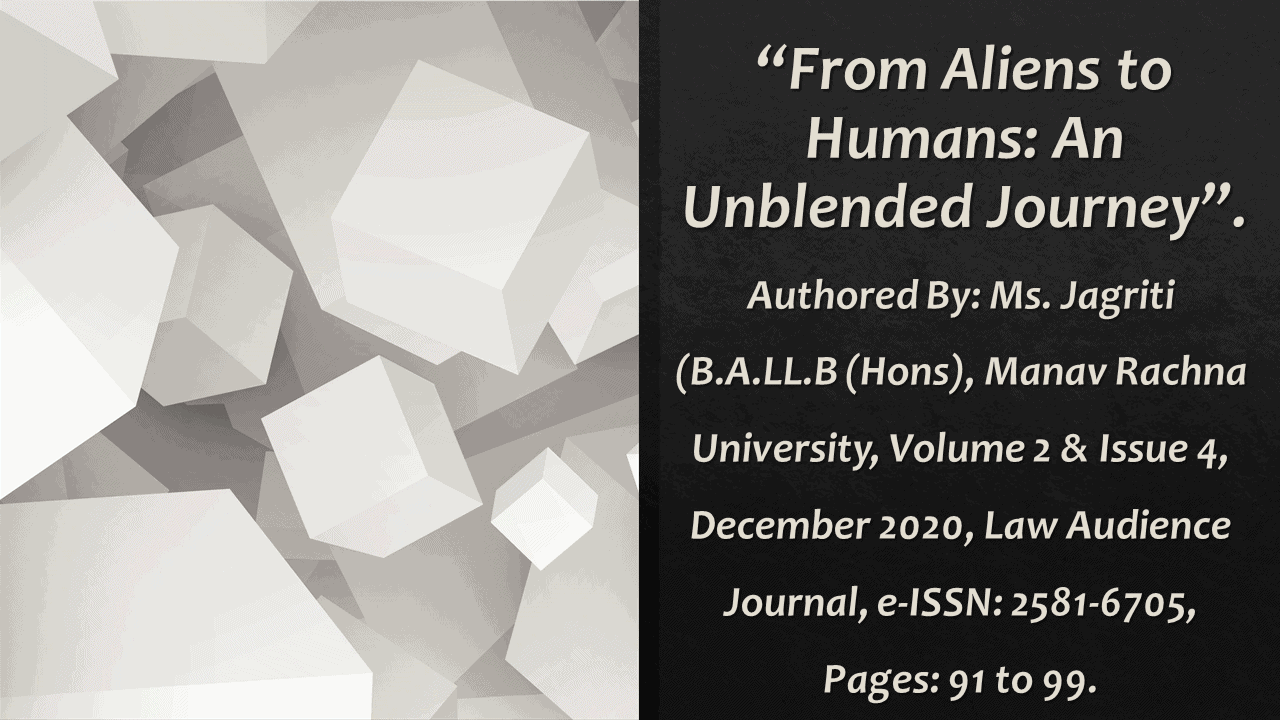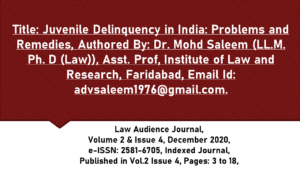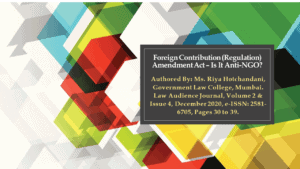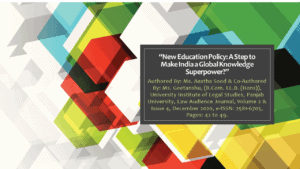Click here to download the full paper (PDF)
Authored By: Ms. Jagriti (B.A.LL.B (Hons), Manav Rachna University.
Click here for Copyright Policy.
Click here for Disclaimer.
I. INTRODUCTION:
Ghosts can exist but a community like LGBT cannot or it’s a syndrome because same-sex can’t develop feelings for each other. Those were some stigmatic thoughts through which the struggle of ten years finally achieved success, as the Section 377 of Indian Penal Code, 1860, was stated unconstitutional “in so far as it criminalizes consensual sexual conduct between adults of the same sex[1]” on the remarkable date of 6th September, 2018.
The emphasis on the unique being of an individual is the salt of his/her life. Denial of self-expression is inviting death. Irreplaceability of individuality and identity is a grant of respect to self. The right to privacy and the protection of sexual orientation lie at the core of the fundamental rights guaranteed by Articles 14, 15 and 21 of the Constitution of which this section was violative of.
The very possibility of prosecution has had on generations of Indians whose sexual orientation was criminalized and made the subject of threats, blackmail, ridicule and repression. It needs to be emphasized that as a minority, the LGBT community, like other minority communities, needs protection – not prosecution, persecution and ostracisation. Recognizing the importance of constitutional morality over social morality, Section 377 was laid unconstitutional in accordance with the transformative constitution. This paper shall aim to cover the history from where their sufferance began to covering all those significant judgments which led to the conquering of Navtej Singh Johar & Ors. v. Union of India[2].
Homosexuality is a sexual attraction or behaviour among the people of the same sex. As a sexual orientation, homosexuality refers to an enduring pattern or disposition to experience sexual affection or romantic attractions primarily to people of the same sex. Based on those attractions, behaviour expressing them, and membership in a community of others who share them, it also refers to an individual’s sense of personal and social identity. The common term used for homosexuals are ‘gays’, ‘lesbians’, ‘bisexuals’, or ‘transgender’ and collectively known as LGBT people.
Definition of LGBT by Michael Kirby, former Judge of the High Court of Australia[3]:
- Homosexual: People of either gender who are attracted, sexually, emotionally and in relationships, to persons of the same sex.
- Bisexual: Women who are attracted to both sexes; men who are attracted to both sexes.
- Lesbian: Women who are attracted to women.
- Gay: Men who are attracted to men, although this term is sometimes also used generically for all same-sex attracted persons.
American Physiological Definition Association:
Transgender: An adjective that is an umbrella term used to describe the full range of people whose gender identity and/or gender role do not confirm to what is typically associated with their sex assigned at birth[4].
We live in a society that continually acquaints us that there is only one kind of acceptable desire- heterosexual, within marriage, and male. Social structures further interpret and shelter rigid notions of what it means to be a man or woman, how the two should relate, and the family unit that should result. All those who stand outside this dogmatized ideal are scrutinized threats to “morality” and to society at large. In response to this threat, the system either tries to altogether deny the existence of those deviating from the norm, or dismisses them as imports from west. When their existence is difficult to defy, they are penalized in ways that deny them a life of dignity and freedom. Section 377, which now stands as unconstitutional and is decriminalised, which earlier as the provision in Indian penal code, criminalised voluntary carnal intercourse against the order of the nature. Individuals belonging to the LGBT group suffer discrimination and abuse throughout their lives due to the existence of Section 377 IPC which is nothing but a manifestation of a mindset of societal values prevalent during the Victorian era where sexual activities were considered mainly for procreation. The said community remains in a constant state of fear which is not conducive for their growth. It is contended that they suffer at the hands of law and are also deprived of the citizenry rights which are protected under the Constitution. Sexual rights have been in the periphery of law, movements, and society for far too long and it is imperious that the pandemic discrimination against the LGBT people and communities be stopped. The decriminalisation of consensual, adult same sex activity will act as the first step towards a larger campaign against Section 377 that would lead to its ultimate repeal and also to the simultaneous drafting of a substantive new law on child sexual abuse. It is only then that a country so proud of its democracy and freedom will be safe for so many that live in fear on its soil.
II. HISTORY:
It has been long argued by the historians that pre-colonial Indian society did not view same sex relationship as immoral or sinful, nor did it criminalize the same. Though some Hindu texts do contain injunctions against homosexuality namely among priests but Hinduism, India’s largest religion, has traditionally portrayed homosexuality as natural and joyful. Hinduism also recognizes a third gender known as hijra. There are several characters in the Mahabharata who convert genders, such as Shikhandi[5] who eventually marries a woman but is born female and identifies. Bahuchara Mata, worshipped by hijras as their patroness, is the goddess of fertility. The SushrutaSamhita[6] and the Nāradasmṛti[7], were important scriptures from ancient India relating to medicine and dharma and, respectively, who forbid homosexuals from marrying a partner of the opposite sex and declare homosexuality to be “incurable”. The Kama Sutra[8], uses the term tritiya-prakriti to define men with homosexual desires and describes lesbians (svairini, who engage in aggressive lovemaking with other women), bisexuals (referred to as kami or paksha), and transgender and intersex people. The European colonisers introduced modern societal homophobia to India and the enactment of Section 377 by the British, which lasted for more than 70 years after Indian independence. Among the Mughal people homosexual acts were regarded as taboo. The British Raj criminalised anal sex and oral sex (for both heterosexuals and homosexuals) under Section 377 of the Indian Penal Code, which entered into force in 1861. This made it an offence for a person to voluntarily have “carnal intercourse against the order of nature.”
III. MENTAL HEALTH CONCERNS OF HOMOSEXUAL COMMUNITIES:
Historically, psychology has been used to scientifically brand homosexual people as ‘sick’, ‘diseased’ or ‘mentally ill’, and, in the process, reinforce the ‘normalcy’ of heterosexuality. While these attitudes are still pervasive amongst many mental health practitioners, international code of ethics and conduct, government, psychiatric and psychoanalytic associations, and human rights covenants alike have together sought to reverse this trend and have successfully refuted the idea that homosexuality is a mental illness. Officially, the Indian psychiatric society accepts the International World Health Organisation and American Psychiatric Association mental health guidelines as laid out in the internationally recognised diagnostic and statistical manual of mental disorders. Homosexuality is no longer within DSM IV, considered a mental illness. Additionally, whosoever seeks to convert or change someone’s sexual orientation, under the guidelines, is prohibited through any means. However, in reality, playing on the prejudices of mental health practitioners, institutions, India remains the sight of physical, personal and emotional violations and abuse, in Mental Health Institutions and Spaces, and using Section 377 as a shield to do so. Social and familial pressures and stigma, the threat of Section 377, struggles with one sexuality, and other human rights violations and humiliation pressed upon homosexual people can and do lead to an absence of a full mental and emotional well-being for many like depression, suicidal feelings and substance abuse. Though, help could be sought from mental health practitioners, yet many a times they are also seen under the pressure from the family, i.e., instead of making them comfortable with their identity, they are supposed to cure them. Directly leading towards the violation of patient’s rights and needs as there is lack of information on sexuality and sexual choice. Then, adding onto it these mental health professionals due to homophobic biases and assumptions are the cause of patient’s lack of well-being. These people have no way of protesting and no refuge against brutish therapy, that degrade them on physical, financial, personal, and other multitudinous levels, for they fear exposure, social stigmas, and even legal actions for expressing themselves out. Reparative Therapies by mental health professionals is a supplemental instance of refusal of rights[9].
IV. TIMELINE OF FIGHT AGAINST SECTION 377:
The Supreme Court has finally struck down a 19th century law criminalizing homosexuality in India. A bench consisting of chief justice Dipak Misra and Justices DY Chandrachud, AM Khanwilkar, Indu Malhotra, and Rohinton Fali Nariman, in a unanimous verdict, held that the members of LGBTQ community have the same sexual rights as any other citizen and homosexuality is legal in India.
Here’s a timeline of the battle against section 377 in India, which began over 20 years ago[10]:
November-December 1991: A document released by the AIDS Bhedbhav Virodhi Andolan (ABVA), an organization fighting discrimination against those affected by HIV or AIDS, reveals the shocking extent of blackmail, extortion, and violence that gay people faced, especially at the hands of the police. The report calls for the repeal of legislation that discriminates against members of the LGBTQ community, including section 377.
May 1994: ABVA filed a writ petition in the Delhi High Court, claimed that free condoms be provided and that section 377 be declared as unconstitutional when Kiran Bedi, inspector general of the Tihar jail in Delhi, repulses to provide condoms for inmates, as it would foster homosexuality. The petition was banished in 2001.
December 2001: Public Interest Litigation (PIL) in the Delhi high court was filed by the NAZ Foundation, a sexual health NGO working with gay men challenging the legality of homosexuality in India. Few months later, the PIL was dismissed by the court.
February 2006: After the NAZ Foundation files a special leave petition for the case; in the coming months, Voices against 377, a coalition of NGOs, joins the petition, while India’s ministry of home affairs files an affidavit against the decriminalization of homosexuality.
July 2009: In a landmark judgment, a Delhi high court bench arbitrates to legalize Section 377, stating it infringes the fundamental rights to life, liberty, and equality as manifested in the Indian constitution. But critics and a Delhi-based astrologer challenged the decision.
December 2013: The LGBTQ community tolerated a significant blow when the Delhi High Court’s decision was overturned by the Supreme Court, stating section 377 “does not suffer from the vice of unconstitutionality and the declaration made by the division bench of the high court is legally unsustainable.”
August 2017: The Court said that discrimination on the basis of sexual orientation is deeply derogatory to the integrity and self-worth of the individual, raising the hopes of those campaigning against section 377.
July 2018: A five-judge bench of the Supreme Court, including chief justice Dipak Misra, began hearing the petitions led by Johar and others against section 377. A central government affidavit leaves the decision on the section’s constitutionality to the court’s wisdom. The Supreme Court decides to reverse its verdict.
September 2018: In a unanimous verdict, the Supreme Court decides to discard Section 377, which Chief Justice Misra expounds as “irrational, indefensible and manifestly arbitrary,” marking a triumphant end to a extensive battle for justice.
V. CONSTITUTIONALITY OF SECTION 377:
The fight for the decriminalization of section 377 is a fight of self, fight for indentify, fight for individuality. It is a movement for the recognition of their existence in the society and conquering what they own already, human rights. Sexual orientation and privacy lie at the core of the fundamental rights which are guaranteed under Articles 14, 19 and 21 of the Constitution and in the light of the decision in Puttaswamy[11]. Articles 15 and 16, includes discrimination on the ground of gender identity. The expression ― sex, used in Articles 15 and 16 is not just limited to biological sex of male or female, but intended to include people who consider themselves to be neither male nor female. Justice J.S. Verma Committee on Amendments to Criminal Law which had observed that sex occurring in Article 15 includes sexual orientation and, thus, Section 377 is violative of Article 15 of the Constitution on this count[12].
Shakti Vahini v. Union of India and others[13], and Shafin Jahan v. Asokan K.M.[14], wherein it has been clearly recognized that an individual’s exercise of choice in choosing a partner is a feature of dignity and, therefore, it is protected under Articles 19 and 21 of the Constitution. It is averred that Section 377 IPC, by creating a taint of criminality, deprives the LGBT persons of their right to reputation which is a facet of the right to life and liberty of a citizen under Article 21 of the Constitution as observed in Kishore Samrite v. State of U.P. and others[15], and Umesh Kumar v. State of Andhra Pradesh and another[16], to the effect that reputation is an element of personal security and protected by the Constitution with the right to enjoyment of life and liberty. Section 377 has a chilling effect on Article 19(1) (a) of the Constitution which protects the fundamental right of freedom of expression including that of LGBT persons to express their sexual identity and orientation, through speech, choice of romantic/sexual partner, expression of romantic/sexual desire, acknowledgment of relationships or any other means and that Section 377 constitutes an unreasonable exception and is thereby not covered under Article 19(2) of the Constitution. In S. Khushboo v. Kanniammal and another[17], wherein it has been held that law should not be used in such a manner that it has a chilling effect on the freedom of speech and expression. Additionally, the view in NALSA case has also been strongly pressed into service to emphasize that the said decision clearly spells out that the right under Article 19(1)(a) includes one‘s right to expression of his/her self-identified gender which can be expressed through words, action, behavior or any other form.
Section 377 violates the rights of LGBT persons under Article 19(1) (c) and denies them the right to form associations. Similarly, such persons are hesitant to register companies to provide benefits to sexual minorities due to the fear of state action and social stigma. Further, a conviction under Section 377 IPC renders such person’s ineligible for appointment as a director of a company. It also impedes the ability of the LGBTs to realize the constitutionally guaranteed right to shelter. LGBTs seek assistance of private resources such as Gay Housing Assistance Resources (GHAR) in order to access safe and suitable shelter and this is an indication that the members of this community are in need of immediate care and protection of the State.
Henceforth, laws which are based upon the notions of social morality and have no legal tenability must be based on human rights principles and standards. So, if we tolerate the denial of human rights in any group, we undermine the protective framework of human rights by taking away its central plank – the equal rights and dignity of all human beings.
VI. CONCLUSION:
The Supreme Court finally decriminalized homosexuality and recognized the constitutional rights of LGBTQ community which led to an immense deluge of emotion and celebrations across the country. Senior advocates and jurists sense the verdict has led to a new door for the community to seek regality in every phase of life. Senior lawyers said that this shall lead to equality. As the order came activists across India cheered and some cried. Activists believe that biasness may still continue. Balachandran Ramiah, a petitioner, said changing people’s mindset may take time[18]. BJP MP Subramanian Swamy said this would give rise to HIV cases, and that the next government would have it overturned[19].
The court emphasizes that the role of the court is to avert violations of fundamental rights, when the legislature and executive have failed to do so. The court recognizes that Section 377 was never just about prosecutions, but about the threat of being prosecuted, about blackmail, fear and the perpetuation of a culture of silence and stigmatization of LGBT identities. The judgment is a direct challenge to the values that underpin honor killings, the obstruction of inter-religious and inter-caste marriages, kidnappings, forced marriages, house arrest, and other forms of violence perpetrated by families on their own kith and kin to protect their reputation.
Justice Indu Malhotra, in her concurring opinion, in an extraordinary statement, states that history owes an apology to LGBTI persons and their families, for the ignominy and ostracism they have suffered through the centuries. Justice Chandrachud called “the right to love not just a separate battle for LGBTQ individuals but a battle for us all”. However, even after this remarkable judgment, a lot more has to be done. If any law has established its roots completely, socially, culturally and legally, then it’s very important to curb out the prejudice which the law has stimulated. The court, through this decision, has solidified the revolutionary power of the Constitution and escalated a way of thinking rooted in the values of respect for integrity, equality and fraternity. If this way of thinking, engraved as it in the struggle against forms of discrimination carried out by a conservative social morality, becomes more welcomed and acknowledged, India will be less of a majoritarian democracy and more of a form of constitutional democracy[20].
[1] Navtej Singh Johar & Others v. Union of India, (2016) 7 SCC 485: (2016) 3 SCC (Cri) 221.
[2] Ibid.
[3] The Hon Justice Michael Kirby AC CMG Justice of the High Court of Australia, Psychiatry, Psychology, Law and Homosexuality – Uncomfortable Bedfellows, available at http://www.lawfoundation.net.au/ljf/app/&id=4F34CAD2DA1F14E9CA2571A3008059FD.
[4] A glossary: Defining transgender terms, available at https://www.apa.org/monitor/2018/09/ce-corner-glossary.
[5] Shikhandi, available at https://en.wikipedia.org/wiki/Shikhandi.
[6] Sushruta Samhita, available at https://en.wikipedia.org/wiki/Sushruta_Samhita.
[7] Nāradasmṛti, available at https://en.wikipedia.org/wiki/N%C4%81radasm%E1%B9%9Bti.
[8] Kama Sutra, available at https://en.wikipedia.org/wiki/Kama_Sutra.
[9] Mental health statistics: LGBT people, available at https://www.mentalhealth.org.uk/statistics/mental-health-statistics-lgbt-people.
[10] Maria Thomas, Timeline: The struggle against section 377 began over two decades ago, available at https://qz.com/india/1379620/section-377-a-timeline-of-indias-battle-for-gay-rights/.
[11] (2017) 10 SCC 1.
[12] Justice J.S. Verma Committee on Amendments to Criminal Law, available at https://www.thehindu.com/multimedia/archive/01340/Justice_Verma_Comm_1340438a.pdf.
[13] (2018) 7 SCC 192.
[14] AIR 2018 SC 1933: 2018 (5) SCALE 422.
[15](2013) 2 SCC 398.
[16] (2013) 10 SCC 591.
[17] (2010) 5 SCC 600.
[18] Harish V Nair, Section 377: The challenges after landmark Supreme Court verdict, available at https://www.indiatoday.in/mail-today/story/even-as-lgbtq-celebrate-landmark-supreme-court-verdict-social-challenges-may-stay-1334101-2018-09-07.
[19] Available at https://www.news18.com/news/india/it-will-give-rise-to-hiv-cases-gay-bars-bjps-subramanian-swamy-frowns-at-sc-verdict-on-sec-377-1869533.html.
[20] supra note 1.



